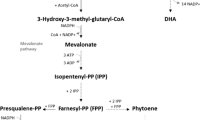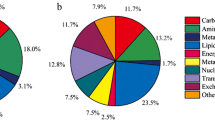Abstract
Thraustochytrium sp. ATCC 20892 produced high yields of docosahexaenoic acid (DHA), more than four other strains of Thraustochytrium and Schizochytrium tested, but insignificant amounts of other polyunsaturated fatty acids. Glucose and sodium glutamate were the preferred carbon and nitrogen sources, respectively, and the optimum conditions for growth and DHA production were pH 7.0 at 25°C with 40 g glucose 1-1 for 4 days. Temperature profiling under these optimum conditions further enhanced the yield and volumetric productivity of DHA.
Similar content being viewed by others
References
Bajpai, P., Bajpai, P.K. & Ward, O.P. 1991a Production of docosahexaenoic acid by Thraustochytrium aureum. Applied Microbiology and Biotechnology 35, 706–710.
Bajpai, P.K., Bajpai, P. & Ward, O.P. 1991b Optimization of production of docosahexaenoic acid (DHA) by Thraustochytrium aureum ATCC 34304. Journal of the American Oil Chemists' Society 68, 509–514.
Bimbo, A.P. 1987 The emerging marine oil industry. Journal of the American Oil Chemists' Society 64, 706–715.
Bligh, E.G. & Dyer, W.J. 1959 A rapid method of total lipid extraction and purification. Canadian Journal of Biochemistry and Physiology 37, 911–917.
Braden, L.M. & Caroll, K.K. 1986 Dietary polyunsaturated fat in relation to mammary carcinogenesis in rat. Lipids 21, 285–288.
Chilton, F.H., Patel, M., Fontch, A.N., Hubbard, W.C. & Triggiani, M. 1993 Dietary ω-3 fatty acid effects on neutrophil lipid composition and mediator production. Influence of duration and dosage. Journal of Clinical Investigation 91, 115–122.
Chu, F.E. & Dupuy, J.L. 1980 The fatty acid composition of three unicellular algal species used as food sources for larvae of the American oyster (Crassostrea virginica). Lipids 15, 356–364.
Connor, W.E., Martha, N. & Lin, D.S. 1990 Dietary effects on brain fatty acid composition, the reversibility of ω-3 fatty acid deficiency and turnover of docosahexaenoic acid in brain, erythrocyte and plasma of rhesus monkey. Journal of Lipid Research 31, 237–247.
Dyerberg, H. 1986 Linoleate-derived polyunsaturated fatty acids and prevention of atherosclerosis. Nutritional Review 44, 125–134.
Holub, B.J. & Skeaff, C.M. 1987 Nutritional regulation of cellular phosphatidylinositol. Methods of enzymology 141, 234–244.
Kendrick, A. & Ratledge, C. 1992 Lipids of selected molds grown for the production of ω-3 and ω-6 polyunsaturated fatty acids. Lipids 27, 15–20.
Krukonis, V.J. 1984 Supercritical fluid fractionation of fish oils: concentration of eicosapentaenoic acid. Journal of the American Oil Chemists' Society 61, 698.
Leaf, A. & Weber, P.C. 1988 Cardiovascular effects of ω-3 fatty acids. New England Journal of Medicine 318, 549–551.
Li, Z.Y. & Ward, O.P. 1994 Production of docosahexaenoic acid by Thraustochytrium roseum. Journal of Industrial Microbiology 13, 238–241.
Nilsson, W.B., Ganglitz, E.J., Hudson, J.K., Stout, V.F. & Spinelli, J. 1988 Fractionation of menhaden oil ethyl esters using supercritical fluid CO2. Journal of the American Oil Chemists' Society 65, 109–117.
Ratledge, C. 1989 Microbial lipids, Vol. 2, London: Academic Press.
Shimizu, S., Kawashima, H., Akimoto, K., Shinmen, Y. & Yamada, H. 1988a Microbial conversion of oil containing α-linolenic acid to an oil containing eicosapentaenoic acid. Journal of the American Oil Chemists' Society 66, 342–347.
Shimizu, S., Shinmen, Y., Kawashima, H., Akimoto, K. & Yamada, H., 1988b Fungal mycelia as a novel source of eicosapentaenoic acid production: Activation of enzyme(s) involved in eicosapentaenoic acid production at low temperature. Biochemistry and Biophysics Research Communications 150, 335–341.
Suutari, M. & Laaski, S. 1994 Microbial fatty acids and thermal adaptation. Critical Reviews in Microbiology 20, 285–328.
Tyrell, D. 1967 The fatty acid composition of 17 Entomophthora isolates. Canadian Journal of Microbiology 13, 755–760.
Ward, O.P. 1995 Microbial production of long-chain polyunsaturated fatty acids. Inform 6, 683–688.
Yano, Y., Nakayama, A., Sato, H. & Ishihara, K. 1994 Production of docosahexaenoic acid by marine bacteria isolated from deep sea fish. Lipids 29, 527–528.
Yongmanitchai, W. & Ward, O.P. 1989 Omega-3 fatty acids: altemative sources of production. Process Biochemistry 24, 117–125.
Author information
Authors and Affiliations
Rights and permissions
About this article
Cite this article
Singh, A., Wilson, S. & Ward, O.P. Docosahexaenoic acid (DHA) production by Thraustochytrium sp. ATCC 20892. World J Microbiol Biotechnol 12, 76–81 (1996). https://doi.org/10.1007/BF00327806
Received:
Accepted:
Issue Date:
DOI: https://doi.org/10.1007/BF00327806




